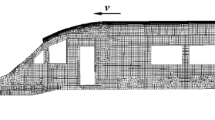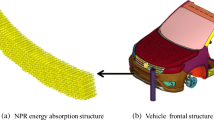Abstract
In this paper, two optimization approaches to improve the product design process have been analysed. Through the analysis of a case study, concerning the designing of a new High Energy Absorption Rear Underrun Protective Device (HEARUPD), two different optimization approaches (simplex and simulated annealing) have been compared. In the implemented optimization processes, the crash between an economy car and the rear part of a truck has been simulated by dynamic numerical (FEM) analyses. Moreover, authors have proposed the use of a suitable linear function of four variables with the purpose of reducing the multi-objective optimization processes to mono-objective ones. That has been made to simplify the analysis procedures without affecting the quality and the completeness of the optimization processes. The obtained results, as well as showing the high effectiveness of the integrated use of numerical crash analyses and optimization methods, demonstrate that simplex method is more effective than simulated annealing one for optimization problems where the single analysis loop requires much time. Even if the solutions are quite similar in terms of calculated values of the objective function, design and state variables, simplex method needs shorter computational time than simulated annealing to obtain an optimized solution.
















Similar content being viewed by others
References
Cappello F, Ingrassia T, Mancuso A, Nigrelli V (2005) Methodical redesign of a semitrailer. In: Hernandez S, Brebbia CA (eds) Computer aided optimum design in engineering IX. WIT Press, UK. ISBN: 1-84564-016-0, ISSN: 1746–4498
Nocedal J, Wright SJ (1999) Numerical optimization. Springer, Berlin
Vanderplats GN (1984) Numerical optimisation techniques for engineering design. McGraw-Hill, Monterey
Pantelides CP, Tzan SR (2000) Modified iterated simulated annealing algorithm for structural synthesis. Adv Eng Softw 31:391–400
Leite JPB, Topping BHV (2000) Improved genetic operators for structural engineering optimization. Adv Eng Softw 29(7):529–562
Raich AM, Ghaboussi J (2000) Evolving structural design solutions using an implicit redundant genetic algorithm. Struct Multidiscip Optim 20:222–231
Durand MD, White SR (2000) Trading accuracy for speed in parallel simulated annealing with simultaneous moves. Parallel Comput 26:135–150
Park HS, Sung CW (2002) Optimization of steel structures using distributed simulated annealing algorithm on a cluster of personal computers. Comput Struct 80:1305–1316
Cantu-Paz E, Goldberg DE (2000) Efficient parallel genetic algorithms: theory and practice. Comput Methods Appl Mech Eng 186:221–238
Press WH, Flannery BP, Teukolsky SA, Vetterling WT (1992) Numerical recipes in FORTRAN. The art of scientific computing. Cambridge University Press, Cambridge
Conn AR, Scheinberg K, Vicente LN (2003) Geometry of sample sets in derivative free optimization. Part I: polynomial interpolation. http://www.mat.uc.pt/lnv/papers/reports.html
Luenberger DG (1984) Linear and nonlinear programming. 2nd edn., Addison-Wesley, Reading, ISBN: 1-4020-7593-6
Holland J (1975) Adaptation in natural and artificial systems. Michigan University Press, Ann arbor
Cappello F, Mancuso A (2003) A genetic algorithm for combined topology and shape optimisations. Comput Aided Des 35(8):761–769
Zhang ZQ, Zhou JX, Zhou N, Wang XM, Zhang L (2005) Shape optimization using kernel particle method and an enriched genetic algorithm. Comput Methods Appl Mech Eng 194:4048–4070
Nabli H (2009) An overview on the simplex algorithm. Appl Math Comput 210:479–489
Benhamadou M (2002) On the simplex algorithm ‘revised form’. Adv Eng Softw 33:769–777
Zain AM, Haron H, Sharif S (2010) Genetic algorithm and simulated annealing to estimate optimal process parameters of the abrasive waterjet machining. Engineering with Computers. doi 10.1007/s00366-010-0195-5
Dantzig GB (1963) Linear programming and extensions. Princeton University Press, Princeton
Koshel RJ (2002) Enhancement of the downhill simplex method of optimization. In: Paper presented at international optical design conference, Arizona, 3 June 2002
Nelder JA, Mead R (1965) A simplex method for function minimization. Comput J 7:308–313
Metropolis N, Rosenbluth A, Rosenbluth M, Teller A, Teller E (1953) Equation of state calculations by fast computing machines. J Chem Phys 21:1087–1092
Kirkpatrick S, Gelatt CD, Vecchi MP (1983) Optimization by simulated annealing. Science 220(4598):671–680
Lamberti L (2008) An efficient simulated annealing algorithm for design optimization of truss structures. Comput Struct 86:1936–1953
Behzadi B, Ghotbi C, Galindo A (2005) Application of the simplex simulated annealing technique to nonlinear parameter optimization for the SAFT-VR equation of state. Chem Eng Sci 60:6607–6621
Mahmoud H, Alrefaei A, Diabat H (2009) A simulated annealing technique for multi-objective simulation optimization. Appl Math Comput 215:3029–3035
Aarts E, Korst J (1990) Simulated annealing and Boltzmann machines. Wiley, Chichester
Tarng YS, Ma SC, Chung LK (1995) Determination of optimal cutting parameters in wire electrical discharge machining. Int J Mach Tools Manuf 35(12):1693–1701
Cardoso MF, Salcedo RL, Azevedo SF (1996) The simplex simulated annealing approach to continuous nonlinear optimization. Comput Chem Eng 20:1065–1080
ANSYS LS-DYNA user’s guide. http://www.ansys.com/Products/Simulation+Technology/Explicit+Dynamics/ANSYS+LS-DYNA
Hughes T (1987) The finite element method: linear static and dynamic finite element analysis. Prentice Hall Inc, Englewood Cliffs
Newmark NM (1959) A method of computation for structural dynamics. J Eng Mech Div ASCE 85:67–94
Levy H, Lessman F (1992) Finite difference equations. Dover, Mineola. ISBN: 0-486-67260-3
Langwieder K, Gwehenberger J, Kandler M (2001) Rear underrun protection system in commercial vehicles. ATZ Automobiltechnische Zeitschrift worldwide eMagazines (edn 05). http://www.atzonline.com/index.php;do=show/site=a4e/sid=3208789504ff19ce5e50d5070013017/alloc=3/id=1481
Ingrassia T, Nigrelli V (2010) Design optimization and analysis of a new rear underrun protective device for truck. In: Proceedings of the 8th international symposium on tools and methods of competitive engineering (TMCE), Ancona, 12–16 Apr 2010
Cardoso M, Salcedo R, Fevo De Azeveoo S (1996) The simplex-simulated annealing approach to continuous non-linear optimization. Comput Chem Eng 2(9):1065–1080
Hedar A, Fukushima M (2002) Hybrid simulated annealing and direct search method for nonlinear unconstrained global optimization. Optim Methods Softw 17(5):891–912
Author information
Authors and Affiliations
Corresponding author
Rights and permissions
About this article
Cite this article
Ingrassia, T., Nigrelli, V. & Buttitta, R. A comparison of simplex and simulated annealing for optimization of a new rear underrun protective device. Engineering with Computers 29, 345–358 (2013). https://doi.org/10.1007/s00366-012-0270-1
Received:
Accepted:
Published:
Issue Date:
DOI: https://doi.org/10.1007/s00366-012-0270-1




